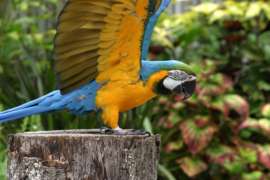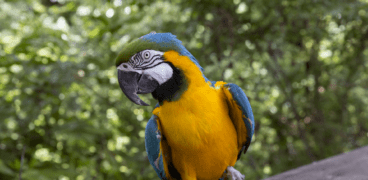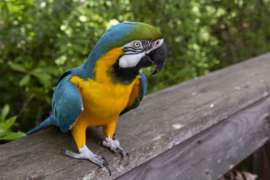Blue-and-yellow Macaw
Blue-and-yellow Macaw
Macaws are large members of the parrot family found throughout Central and South America. Their bright colors and loud vocalizations are important tools for communication but also make them easy targets for poachers.
Blue-and-yellow macaw
Herbivore
South America [VIEW MAP]
Grasslands, Rainforests
Look for Cortez the blue-and-yellow macaw in a bird presentation at the World of Wild Theater with his other feathered friends or at Amy’s Tree Theater. Check today’s schedule for show times.
Photos and Videos
Like many parrots, macaws are long-lived, sometimes reaching ages of upwards of 50 years. More commonly they have a 30 to 45year lifespan. Blue-and-yellow macaws are commonly found in the pet trade. Within the United States, most parrots are bred for the pet trade; however, they do not make good pets for most people.
Macaws make a variety of vocalizations, including loud calls, squawks and screams which echo through the forest canopy. In the wild, these vocalizations help them mark their territory, identify one another, and communicate with their flock. Inside a house, they are loud, destructive, and require more attention than domestic animals like dogs or cats. They often bond with a single household member and may exhibit aggressive behaviors toward anyone else that approaches them.
Blue-and-yellow macaws are large parrots weighing about 2 pounds. They have a 3 to 4-foot wingspan and a 1 to2 foot-long tail that helps guide them as they soar through the air. Their upper bodies are blue, while their undersides are golden yellow. The long tail feathers are mainly blue and yellow. The chin and cheek area is pinkish-white with thin lines of black feathers. Coloration on juveniles is dull and becomes brighter with age. These macaws have a hooked beak which is grey-black in color. Like other parrots, blue-and-yellow macaws are zygodactyl – their dark grey feet have two toes pointing forward and two toes pointing backward, each with a black claw.
Blue-and-yellow macaws look very similar to blue-throated macaws, another species here at the Zoo. You can tell the two species apart by looking for a few key differences. The blue-and-yellow macaw has a green forehead and fewer lines of black feathers within its pinkish-white cheek area. While both species have a patch of dark feathers under their chins, the blue-and-yellow macaw’s is darker and does not continue up its cheeks like the blue-throated macaws’ turquoise patch.
Blue-and-yellow macaws, like many other parrots, are monogamous for life. Bonded pairs fly close to one another within the flock. They reach sexual maturity around 3 to 4 years of age and breed seasonally based on their location. Pairs will nest in tree hollows or cavities that are very high up in trees. A clutch (group of eggs) usually contains 2 to 3 eggs and parents incubate the eggs for 24 to 38 days. Young are independent around three months after hatching, but before then both parents are involved in rearing the hatchlings, which are born without feathers and are extremely vulnerable to predation.
Look for Cortez the blue-and-yellow macaw in a bird presentation at the World of Wild Theater with his other feathered friends or at Amy’s Tree Theater. Check today’s schedule for show times.
Blue-and-yellow macaws are common in South America, from Venezuela to Brazil, Bolivia, Colombia and Paraguay. They are restricted to Panama in Central America. There are some reports of wild macaws living in Mexico and Florida; however, these are likely colonies started by escaped pets.
They can be found throughout subtropical and tropical forests, woodlands and savannas within their range.
Blue-and-yellow macaws’ wild diet is a mix of seeds, nuts, and fruit. Their powerful beaks allow them to crack open hard-shelled nuts that other animals are unable to get into. They are messy eaters, dropping a lot of food from their mouths and enabling other animals to get in on the feast. At the Zoo, they are fed a diet of commercially-prepared parrot chow, fruit, vegetables, seeds and nuts.
Current population numbers are unknown, but the population appears to be declining due to habitat loss, which results in a decrease of nesting sites. Historical capture of wild macaws for the international pet trade has also led to population declines. Some macaw species have gone extinct in the wild due to capture. Fortunately, these parrots are adaptive and have learned to live in urban environments, making the loss of forest habitat less strongly felt than with some other rainforest species.



